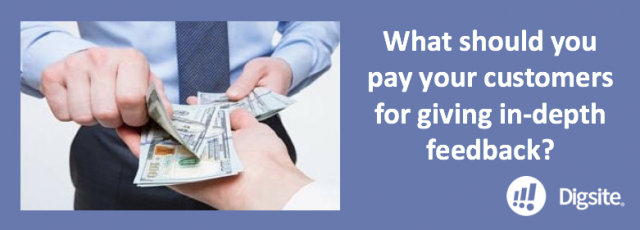
You’ve got some important decisions to make about your products or services. But before you forge ahead, you want to make sure you really understand what makes the most sense for the people who make or break your business; your customers. The questions you have can’t be answered by checking a few boxes. You need in-depth answers to know how they are using your products currently, what features or benefits they really value, and how you can optimize your offering to gain their loyalty.
So, how much should you pay for their feedback? Put differently, how much is their feedback worth? Here are a few general rules to keep in mind so you can get approval for the research you desperately need easier!
Putting a Price Tag on Participation
Focus groups, phone interviews, and onsite interviews are typically the most expensive option for incentives. Most focus group facilities will recommend paying participants $75-$100 an hour for these types of interviews. If your consumers are high-income professionals, you can expect to pay upwards of $300 an hour! If your research topic or brand is something consumers are really passionate about, you might be able to lower your incentives by up to 50% by disclosing the company sponsor.
But, you will want to consider what you are asking participants to do. If you are asking customers to do pre-work, like go to the store, take photos or video journals, you will want to budget another $25 for each additional 30 minutes of their time. Don’t forget, you’ll want to cover expenses like parking or purchasing product too. The expenses seem to continue to add up, so how can you save on these incentive costs?
Online Communities - A New Approach to Qualitative Research
Consider conducting your research in an online insight community, such as Digsite. Participants can come into the community at any time of the day for just 10-15 minutes to complete activities, and typical communities will take place over a 1-5 day span. Participants enjoy the flexibility to come and go as they please and the ability to participate on their mobile device and you enjoy the lower cost of incentives! A typical incentive is $5 per 10-15 minute activity – or $20 for a typical 4 day community.
Similar to in-person research, you can expect to pay more for business professionals, or complex activities such as an online photo or video diary. However, rather than providing cash for participants, online research is often rewarded through Amazon Gift cards which is instantaneous for the participants and easier for you to manage. Some communities offer partial rewards for those who are not as engaged and extra rewards for those who go above and beyond in providing thoughtful responses. This keeps the incentives fair and competitive for both you and the participants.
But you’re probably wondering, does paying a lower incentive mean you are getting less valuable feedback? Absolutely not!
When you use online methods that give participants the ability to answer questions on their own time, you will find they often give more in-depth responses compared to being put on the spot in an in-person interview. Also, modern platforms like Digsite are designed to mimic social media sites, which encourages more group engagement than older research technology. Participants find this approach fun, which keeps them coming back!
Failling Response Rates Cause for Concern With Surveys
Are you considering a survey for in-depth feedback? Increasing incentives might not be enough to make this approach work. These days, participants tend to drop out of surveys that take more than a few minutes to complete,or include multiple open-ended questions. And, surveys that are administered by national panel companies typically pay participants $1 or less for completing a survey. These low incentives often attract participants who are used to checking boxes, not providing thoughtful answers.
If you try to conduct a survey with lots of open-ended questions, you may find these panelists provide very short responses, rather than the robust answers you were looking for. Also, unlike in-person discussions or online insight communities, you typically can’t go back to survey respondents to clarify what they meant either.
Marketing research expert Ray Poynter of NewMR expands on this topic in our blog post, "Quantitate Research Response Rates Falling: What's the Solution."
Before deciding which approach to take, you might want to compare the total cost of your research approach relative to the value you want to get. You may find online insight communities, like Digsite, give you the ability to get richer insights from more people, without breaking the bank on incentives.
Get access to all our resources, including our original research reports, by signing up for our newsletter!



